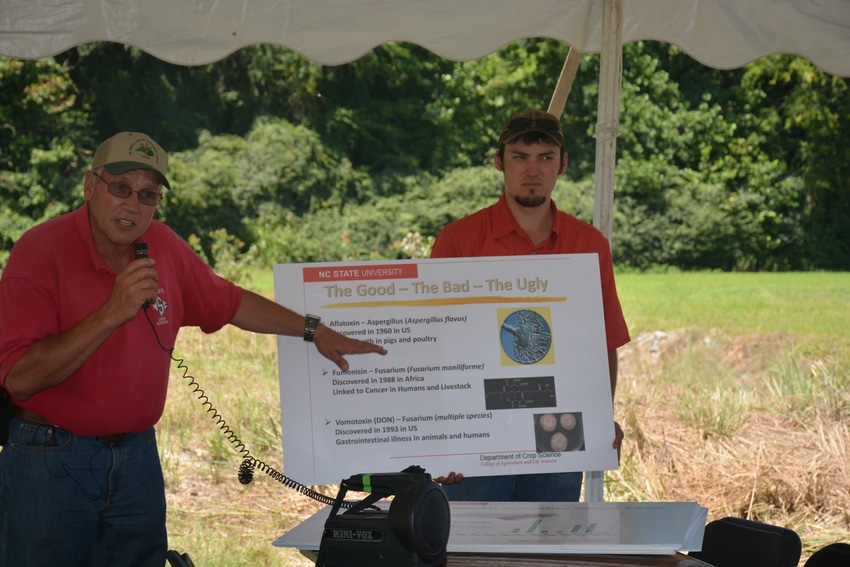
The issue of mycotoxins in corn isn’t one of the most pleasant conversational topics for corn farmers, but North Carolina Extension Corn Specialist Ron Heiniger stresses that mycotoxins are a major concern in North Carolina that needs to be addressed.
“There are no good mycotoxins. We want it gone, stomped out, eliminated. It’s just like a weed in a field. There is no good weed, and the same is true about mycotoxins,” Heiniger said at a corn aflatoxin control field day held Aug. 14 at the Upper Coastal Plain Research Station’s Fountain Farm in Rocky Mount.
A mycotoxin that is of top concern in North Carolina is aflatoxin which is caused by ear rot fungi Aspergillus Flavus, according to Heiniger. Aflatoxin is harmful to livestock and humans, and by law corn with high mycotoxin levels cannot be sold and should not be harvested, Heiniger said.
“Fungal infections of the ear occur during pollination,” Heiniger explained. “Drought stress results in a lack of synchrony between pollen shed by the tassel and the emergence of the silks from the ear and increases the chance that pollen will not be viable when it reaches the silk tube.”
Heiniger said this means the silk tube is often longer and less resistant to fungal spores. In addition, he points out, kernel sites where pollination has failed to occur have ideal conditions for harboring and incubating fungal pathogens.
Want access to the very latest in agriculture news each day? Subscribe to Southeast Farm Press Daily. It’s free!
Heiniger said infection through the silk tube is the most common infection that occurs in North Carolina, causing the biggest problem for farmers.
“While the infection occurs during pollination, the key to ear rot damage lies in ideal conditions for growth of the fungal pathogen during the period form corn pollination to physiological maturity,” Heiniger said. “Frequent rainfall events provide the ideal climate of moisture and high humidity needed for fungal growth and reproduction.”
Heiniger said drought damage leads to lack of good shuck coverage which allows rainfall to penetrate the shuck and holds the moisture next to developing kernels. “Once the corn reaches physiological maturity, the kernel is sealed off by the black layer and fungal infections become worse, leading to the production of mycotoxins,” Heiniger said.
There are steps that farmers can take to control mycotoxins, including maintaining good pH, avoiding drought damage, irrigate if possible and use Bt hybrids, Heiniger said. “Harvest early,” he added. “Don’t give it a chance to get that fungi growing and producing more of that metabolic problem.”
Check current corn futures prices
Heiniger acknowledges that many of these control mechanisms are difficult for growers. For example, not all growers can irrigate. However, scouting the fields to determine if you have a problem is critical, he said.
“Growers should conduct a thorough field sampling and look for the presence of a gray-green mold in the kernels at the tip or base of the ear or for the presence of a white mold or white starburst pattern in the kernels at the tip of the ear,” he advised.
Heiniger said the presence of either of these symptoms indicates that either Aspergillus Flavus or Fusarium moniliform has developed in the field. “Although they are indicators of a potential problem, the fact that corn has gray-green or white mold does not automatically mean that mycotoxins are present,” he said.
The bottom line, Heiniger stressed, is for farmers to scout their fields for mold, and if it is present, they should have a sample analyzed for mycotoxins. “If mold is present but mycotoxins are not found, then plan to harvest early to prevent further infection,” Heiniger said.
About the Author(s)
You May Also Like






